Florina,West Macedonia 作者: 来源: 发布时间:2021-07-13
I.Population and Area
Location within the region
Coordinates: 40°47′N 21°24′E
Country Greece
Administrative region
Regional unit Florina
Government
• Mayor Ioannis Voskopoulos
Area
• Municipality 819.7 km2 (316.5 sq mi)
• Municipal unit 150.6 km2 (58.1 sq mi)
Elevation 687 m (2,254 ft)
Population (2011)
• Municipality 32,881
• Municipality density 40/km2 (100/sq mi)
• Municipal unit 19,985
• Municipal unit density 130/km2 (340/sq mi)
Community
• Population 17,907 (2011)
Time zone UTC+2 (EET)
• Summer (DST) UTC+3 (EEST)
Postal code 531 00
Area code(s) 23850
Vehicle registration ΡΑ*
Florina (Greek: Φλώρινα, Flórina; known also by some alternative names) is a town and municipality in the mountainous northwestern Macedonia, Greece. Its motto is, 'Where Greece begins'.
The town of Florina is the capital of the Florina regional unit and also the seat of the eponymous municipality. It belongs to the administrative region of West Macedonia. The town's population is 17,686 people (2011 census). It is in a wooded valley about 13 km (8 mi) south of the international border of Greece with the Republic of North Macedonia.
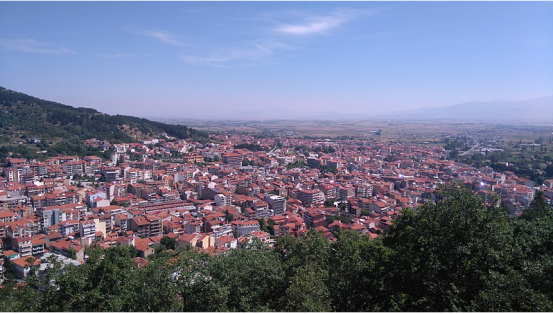
II.Natural Geography (environment and resources)
Geography
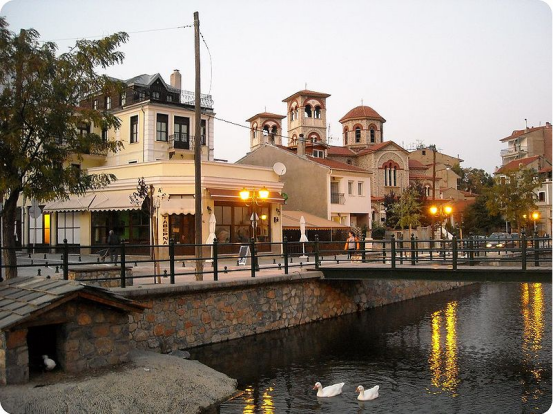
Sakoulevas river and the Cathedral of Florina.
Florina is the gateway to the Prespa Lakes and, until the modernisation of the road system, of the old town of Kastoria. It is located west of Edessa, northwest of Kozani, and northeast of Ioannina and Kastoria cities. Outside the Greek borders it is in proximity to Korçë in Albania and Bitola in North Macedonia. The nearest airports are situated to the east and the south (in Kozani). The mountains of Verno lie to the southwest and Varnous to the northwest.
Winters bring heavy snow and long periods of temperature below freezing point. Furthermore, the town and the surrounding valley is usually covered in thick fog during the winter months that may last even for weeks under specific conditions. During the summer months it becomes a busy market town with an economy boosted by summer and, mostly, winter tourism due to the heavy snowfalls and the nearby ski resorts.
Even though Florina was the site of the first rail line built in the southern Ottoman provinces in the late 19th century, its rail system remains undeveloped. Today, Florina is linked by a single track standard gauge line to Thessaloniki and Bitola, and to Kozani (meter gauge) where it was intended to continue south and link up with the terminal in Kalambaka, in Thessaly but this did not proceed due to the 1930s financial crisis.
Florina is passed by GR-2 (Lake Prespa - Edessa) and GR-3/E65 (Kozani - Florina - Niki - Bitola). The new Motorway 27 (A27) will run east of Florina with its Florina-Niki segment already operational since 2015. The historic Via Egnatia is situated to the east.
Climate
Florina is one of the coldest towns in Greece, because of its elevation and geographic position. Heavy snowfalls, thick fog and below-freezing temperatures are common during the winter months, while the summers are mild. Under the Köppen climate classification, Florina has a humid subtropical climate (Cfa) with strong hot-summer continental climate (Dfa) influences.
On 18 January 2012, a temperature of -25.1 °C was recorded by the HNMS's station with several reports, however, in the local press for temperatures in villages of the municipality that reached -32 °C, but there was no official record of such temperature. The National Observatory of Athens's station reported a temperature of -22.2 °C a day earlier in Florina, while the same station continuously recorded minimum temperatures below -20 °C from 16 January 2012 until 19 January 2012, with the average maximum temperature for January just -0.6 °C, and the prevalence for 13 consecutive days of temperatures below 0 °C 24 hours a day. The above situation resulted in the Greek General Secretariat of Civil Protection to declare the municipality of Florina in a state of emergency on 16/1/12, at the request of the mayor of Florina, due to the polar temperatures and the intense snowfall that prevailed for days.
Transport
Rail
The city is served by Florina station on the Thessaloniki–Bitola line, with local trains to Thessaloniki.
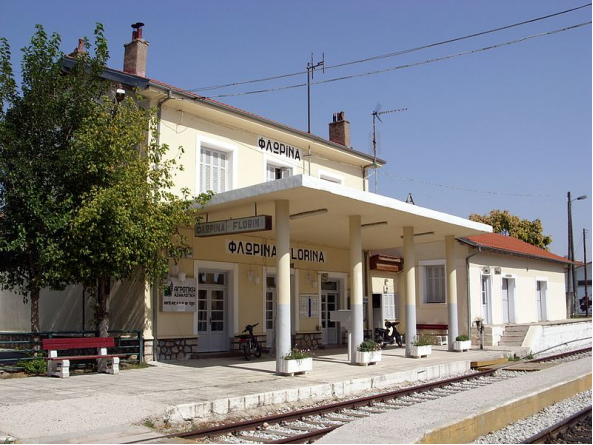
Florina railway station (Greek: Σιδηροδρομικός σταθμός Φλωρίνης, romanized: Sidirodromikós stathmós Florínis) is a railway station in Florina, a town in Western Macedonia, Greece. It is situated at the Greek terminus of the Thessaloniki–Bitola railway. It was opened in 1894, along with the line. It is served by local trains to Thessaloniki.
III.Economy
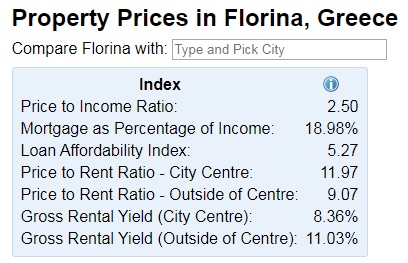
Reference: https://www.numbeo.com/property-investment/in/Florina-Greece
IV.Industrial Characterisitics
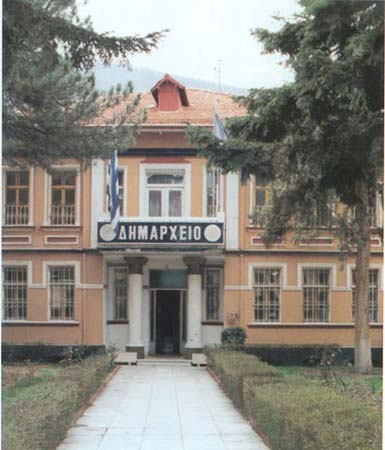
The town hall
Florina is a market town with an economy dominated by agriculture, forestry, summer and winter tourism, cross-border trading and the sale of local produce such as grain, grapes, and vegetables including Florina peppers. It also has textile mills and is known for locally manufactured leather handicrafts.
The most notable industrial activity is the very large Ptolemaia-Florina lignite mine.
Its university changed in 2002 from being a branch of the Aristotle University of Thessaloniki, to a part of the University of Western Macedonia. After 2004, four departments that previously belonged to the Aristotle University, reinforced its potential.
Florina has 8 radio stations, 2 daily political newspapers, 4 weekly ones, one women's press and two newspapers on sports.
During the 1950s and 1960s, the area lost much of its population to emigration, both to Athens and Thessaloniki as well as US, Canada, Australia and Germany. Following Greece's EU membership and the economic upturn, many from Germany returned.
V.Attractions
-- Archaeological Museum of Florina
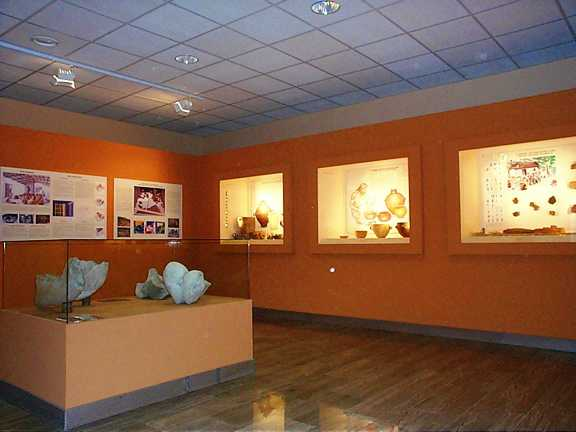
Prehistoric finds, chiefly from the excavations at Armenochori
The Archaeological Museum of Florina is a museum in Florina in West Macedonia, Greece.
The museum is housed in a two-storey building that was constructed in 1969 and renovated internally in 1999. It has prehistoric, Hellenistic, Roman, and Byzantine finds from the Florina area.
The display on the ground floor was organized in 1998 and inaugurated in May 1999 and contains three basic units. The first of these, to the left of the entrance, provides visitors with information about the geomorphology and history of the Florina region from the period of the earliest archaeological finds (about 5800 BC) to the end of the Roman period. However, the main subject of this unit is the activities of humans within the prehistoric period, presented through finds from the excavation of the prehistoric settlement at Armenchori. In the two adjoining rooms are displayed representative examples of sculpture, mainly Roman and include relief grave and votive stelae with various subjects (horsemen, portraits, a funeral banquet, and deified mortals). Other sculptures and inscriptions (all in Greek) provide evidence for the names of persons, cities, religious beliefs, social conditions and political circumstances. There is a fourth room that houses a conserved mosaic from the remains of a Roman building at Kato Kleines.
More specifically, there are ceramic wares, objects for everyday use, materials for building houses, stone and bone tools, spindle whorls, and figurines.
One impressive exhibit consists in the jaws of a 200,000 - 500,000 year old mammoth, which was found in the village of Sotiras. Also on the ground floor are grave stelae of the Roman period from Vevi (2nd–3rd century AD), Petres (2nd century BC), Sitaria (3rd century AD), Vythkouki, Kastoria regional unit (320BC); statues from Vevi (a male torso of the Roman period) and Lakia (a statue of Artemis of the Roman period); and an exceptional mosaic floor from a house of the Roman period at Kato Kleines.
On the first floor are displayed finds of the Hellenistic period from Petres and Agios Pandeleimon Hill, most notably a sundial, a statue of Artemis, agricultural implements, and a reconstruction of a house of the Hellenistic period with its masonry, fireplace, storerooms, and other features.
There are also exhibits of the Byzantine and post-Byzantine period from the Lake Prespa area, chiefly the basilica of Agios Achilleios (capitals, chancel screen closure panels, chancel screen colonnettes), frescoes from various churches, parts of a wood-carved chancel screen from the hermitage of the Transfiguration (Metamorfosi), and an Vema door from the Church of Agios Athanasios in the community of Agios Germanos (16th century).
-- Florina Museum of Modern Art
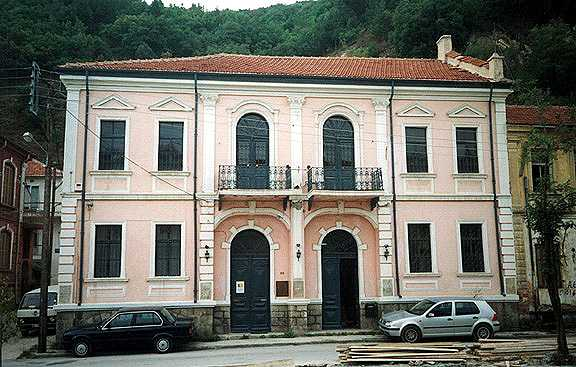
The Florina Museum of Modern Art is an art museum in Florina in Greece. It was founded by the Florina Art Centre in 1977. It is housed in a neoclassical building by the Sakouleva river. The museum's collection is composed of 480 works by 254 artists, which includes paintings, sculptures and engravings. More recently, its collection was enriched by a work of El Greco donated by the national Gallery, as well as by 44 engravings from Florence. These are in display since August 1999. Apart from its permanent exhibition, the museum also organizes art symposia and exhibitions of visual and applied art.
The purpose of the museum is to promote modern Greek culture through products of contemporary art, to cultivate the aesthetic and critical faculties of the local people by mounting solo and group exhibitions of visual art, and to provide schoolchildren with artistic education.
The museum's collection consists of representative paintings, sculptures, and engravings by noted artists of the twentieth century. More specifically, it includes: paintings by Rengos, Plakotaris, Mavridis, Kaniaris, Tetsis, Kokkinidis, Mytaras, Kondos, Kanakakis, Kondogiannis, Tsaras, Xanthopoulos, Botsoglou, Dimitreas, Sahinis, Fokas, Golfinos, Lachas, Kalamaras, Papagiannis, Georgiadis, Zongolopoulos, Perandinos, Koulandianos, Lappas; sculptures by Chalepas; engravings by Hadzikyriakos-Gikas, Rengos, Papageorgiou, Grammatikopoulos, Papadakis, Xenakis, Nikolaou, Sikeliotis, Tsoklis, Moralis, Giannadakis, Nedelkos. A recent addition to the exhibits is a collection entitled ‘Tribute to El Greco’, which was put together from donations from Greek artists to acquire El Greco's ‘St Peter’ from the National Gallery and 44 engravings by 31 foreign artists from Florence. The collection was displayed in the museum in August, 1999.
The museum has a library dedicated to the visual arts, an information archive and an atelier for young people. It frequently organises art symposia and exhibitions of visual and applied art both on its own premises and elsewhere in Greece.
-- The Florina Art Gallery
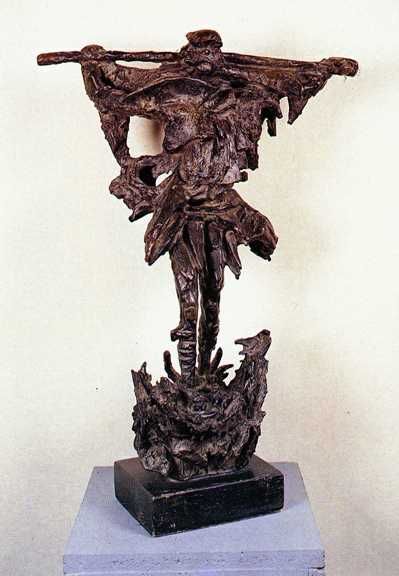
George Koras, Greek shepherd
The Florina Art Gallery (Greek: Πινακοθήκη Φλωρινιωτών) was set up in 1985 by the Florina Art Centre with the aim of collecting, spotlighting, and promoting the artistic output of Florina through the notable work of the local artists, encouraging young people to take an interest in artistic endeavours and pursuits, and inviting scholars to research and study the local artistic tradition.
Its premises are the old railway station building, which the Hellenic Railways Organisation has made over to the Art Centre so that the Gallery can have a permanent home. It stands near the entrance to the town, not far from the Archaeological Museum.
The collection comprises a total of 99 works by 32 local artists: Koulis, Loustas, Gazeas, Tamoutselis, Konstandinidis, Kalamaras, Milossis, Golitsis, Kyrkos, Bessas, Spyrou, Zografos, Lioukras, Rakovalis, Tamoutselis, Papastamatis, Tsoulfidou, Tyrpenos, Tsotsos, Andoniadis, Koras, Vyssios, Vyzandis, Yoftsis, Dotsis, Ioannou, Baras, Papadimitriou, Pavlidis, Sampsonidis, Linaras, and Mihail. The exhibits include paintings, sculptures, drawings, photodrawings, and a hologram, which spotlight the artistic output of Floriniot artists both old and young.
-- Folklore Museum of the Aristotle Association
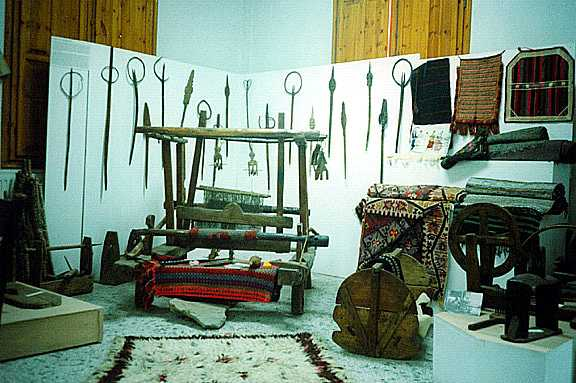
Traditional household utensils
The Aristotle Association was founded in Florina in 1941 for the main purpose of promoting the Greekness of the area. This was as a response to the German occupation of the town which promoted Bulgarian identity. In 1958, some of the members began to collect artefacts of local folk culture (from the Prespa villages and the Florina plain) in the old prison building. In 1987, the folklore collection, which was still growing, was transferred to the Aristotle Association's new premises in the city centre and is now a museum.
Exhibits
The exhibits are displayed in thematic groups. For instance, there is clothing, with the traditional costumes of refugee women from Eastern Rumelia and Northern Epirus, from the villages of Kato Kleines and Flambouro respectively, and many local costumes for young and older people; weaving, with looms, distaffs, spindles, and so on; agricultural occupations’, with tools for ploughing, winnowing, repairing, and so on; household utensils, with saucepans, long-handled coffee-pots, covered casserole dishes; and reception rooms.
There are also tools and examples of occupations that were once very important in the Florina area, such as shoemaking, saddlery, and photography. Of particular note are the examples of wax-weaving, a craft of Byzantine origin that started to flourish in Florina when the refugees from Monastir arrived and continues to the present day.
-- Folklore Museum of the Culture Club
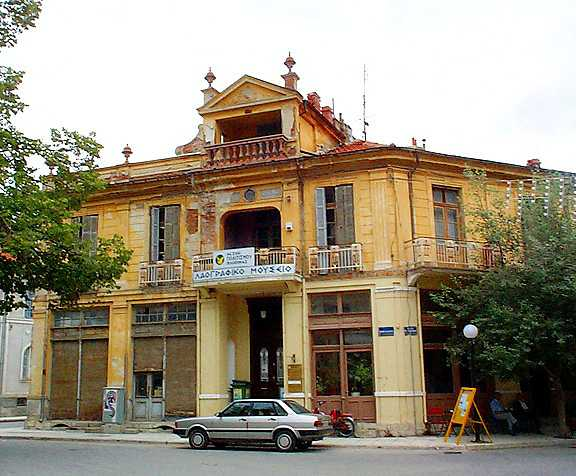
Outside view of the Museum
The Florina Culture Club was founded in 1980, originally as a film club. It later branched out into other activities, one of which was the founding of the Folklore Museum in the former Diethnes Hotel, a building in the eclectic style in the city centre.
The exhibits come from all over the prefecture. The museum’s speciality is exhibits connected with bee-keeping, of which it has one of the finest collections in Greece, which has been included in the Melina educational programme. There is a display of old wooden and clay hives and accessories for collecting honey and royal jelly, and there are also photographs illustrating the art of apiculture as it was practised in days gone by. In the exhibition rooms visitors can also see a variety of traditional everyday wear from the Florina area, looms, weaving implements, agricultural implements (for ploughing, reaping, threshing, and subsidiary activities), objects for everyday use (mainly cooking utensils), and a collection of medicinal plants and aromatic herbs.
VI.History
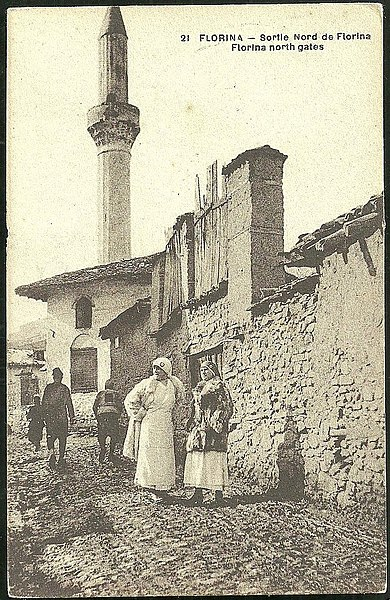
Florina, view from northern entrance (1916-1918)
Within the boundaries of the present-day city lie the remains of a Hellenistic settlement on the hill of Agios Panteleimon. Archaeologists excavated on the site in 1930-1934, but a hotel was later built over the ruins. Excavations began again in the 1980s and the total excavated area is now around 8,000 metres square. The buildings uncovered are mostly residential blocks, and the range of finds suggests that the site was continuously inhabited from the 4th century BC until its destruction by fire in the 1st century BC. Many of these finds are now on display in the Archaeological Museum of Florina.
The town is first mentioned in 1334, when the Serbian king Stefan Dušan established a certain Sphrantzes Palaeologus as commander of the fortress of Chlerenon. By 1385, the place had fallen to the Ottomans. An Ottoman defter (cadastral tax census) for the year 1481 records a settlement of 243 households.
Florina and its inhabitants greatly contributed to the Macedonian Struggle. Prominent leaders included Nikolaos Pyrzas, and Petros Chatzitasis.
In the late Ottoman period the area surrounding Florina supported the Internal Macedonian Revolutionary Organization (IMRO) who fought against the Ottomans. During the Macedonian Struggle the Greek makedonomachoi gained significant advantage towards the Bulgarian Exarchists within 10 months in 1905 and extended their zone of control in various regions of western Macedonia including the plains north and south of Florina. In 1912 came under the control of the Greek forces as a result of the Ottoman defeat in the First Balkan War. Muslim Albanians from Florina and the wider region during the population exchange (1923) based on religious criteria were sent to Turkey, and mainly resettled in Bursa. The town was again in the firing line during World War I, during which it was occupied by Bulgaria, and during the Axis Occupation in World War II, when the town became a centre of Slavic separatism.
For part of the Greek Civil War (1946–1949) the mountains of the Florina area were under communist control. The Slavic-Macedonian National Liberation Front, later simply the National Liberation Front or NOF, had a significant presence in the area: by 1946, seven Slav Macedonian partisan units were operating in the Florina area, and NOF had a regional committee based in Florina. When the NOF merged with the Democratic Army of Greece (DSE), many Slav Macedonians in the region enlisted as volunteers in the DSE. When the Communists were defeated on February 12, 1949 by the Greek army thousands of communists and Slav Macedonians were evacuated or fled to Yugoslavia and the Eastern Bloc.
VII.Other information
Florina in cinema
Movies of the Greek cinema, filmed in the area by Theodoros Angelopoulos include:
-- The Beekeeper (film)
-- The Suspended Step of the Stork
-- Ulysses' Gaze
Historical demographics
In 1821 the Greeks were about 80 families. Austrian diplomat Johann Georg von Hahn visited the city in 1861 and wrote about it in his travel log From Belgrade to Salonica. In it he writes that "[a]bout the houses in Florina, we should indicate that there are at most 3000, with half of the population Albanian and Turkish Muslims and the other half Christian Bulgarians." According to an 1878 French ethnographic book Florina was a town of 1500 households, inhabited by 2800 Muslims and 1800 Bulgarians. In 1896 French diplomat and traveller Victor Bérard visited Florina. The settlement is as described as "consisting of 1500 houses of Albanians and “converted Slavs,” with perhaps a hundred “Turkish” families and 500 Christian families."[28][clarification needed]Bérard noted that “These Slavs nonetheless call themselves Greek and speak Greek—with us at least”.< In 1901/1902 school year statistics, Greek students were clearly much more than the Bulgarian ones.
Greeks from Florina participated in the Greek Revolution of 1821 with the most important fighter being Aggelinas who also fought in Crete while others also fought in Mesologgi. Members of Filiki Eteria were the brothers Loukas Nedelkos and Nikolaos Nedelkos, who were born in the Florina region. The demographic composition of the area the 19th and early 20th centuries is unclear as many factors contributed to the ethnic orientation of the people; out of these religion was particularly important thus giving rise to a proselytism struggle between the Greek Ecumenical Patriarchate of Constantinople and the Bulgarian Exarchate (established in 1870). The actual Greek-speaking element in this area was concentrated in urban centres where it participated in the religious, administrative, social, and educational sectors of life.
Name
The city's original Byzantine name, Χλέρινον (Chlérinon, "full of green vegetation"), derives from the Greek word χλωρός (chlōrós, "fresh" or "green vegetation"). The name was sometimes Latinized as Florinon (from the Latin flora, "vegetation") in the later Byzantine period, and in early Ottoman documents the forms Chlerina and Florina are both used, with the latter becoming standard after the 17th century. The form with (φλωρός) is a local dialect form of χλωρός in Greek. The local Slavic name for the city is Lerin (Лерин), which is a borrowing of the Byzantine Greek name, but with the loss of the initial [x] characteristic of the local dialect. The Albanian name for the city is Follorinë.
VIII.Contact information
Mayor: Mr Ioannis Voskopoulos
Town Hall
FLORINA , MAKEDONIA WEST , GREECE
97, Megalou Alexandrou Street 53100 FLORINA , MAKEDONIA WEST , GREECE
Tel.: +30 23853 51000
Website: http://www.cityoflorina.gr
Reference: https://www.gtp.gr/TDirectoryDetails.asp?ID=13816
